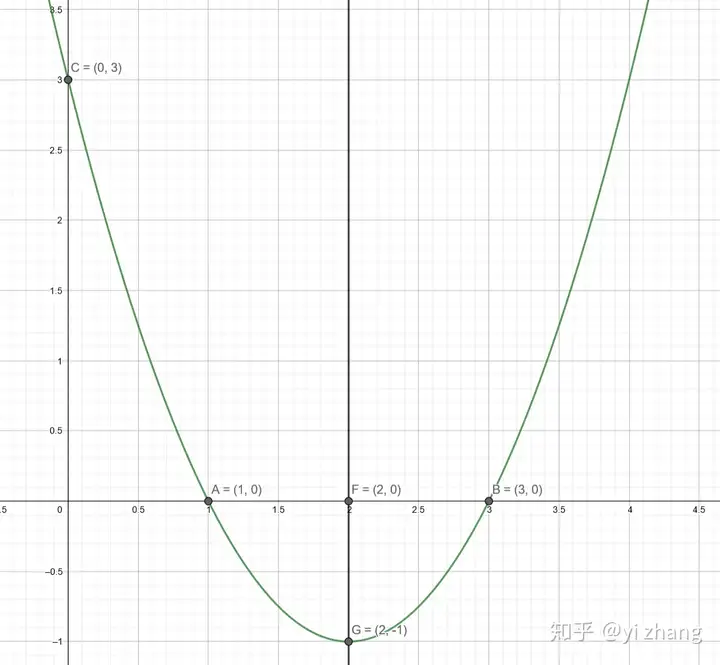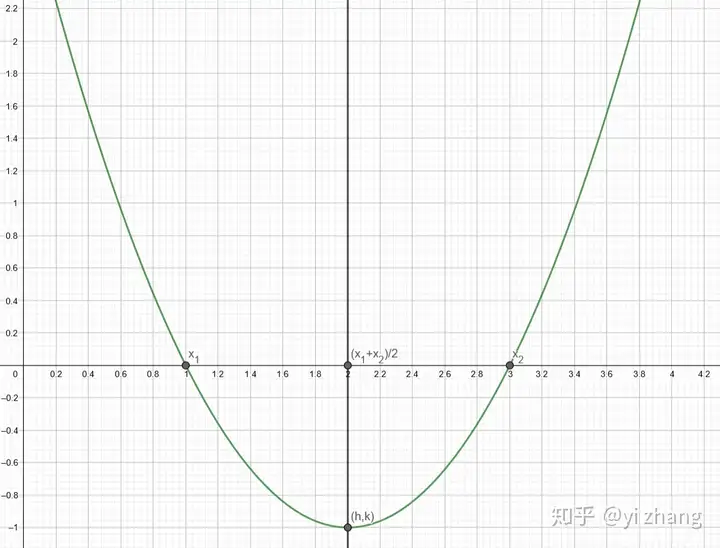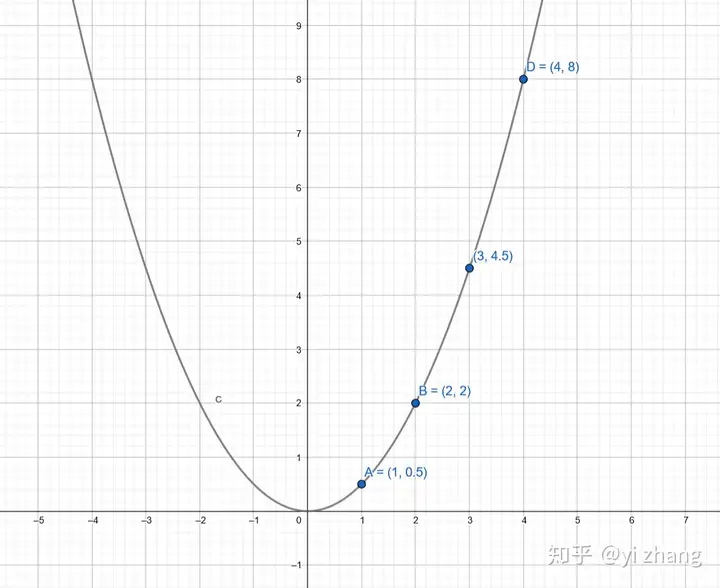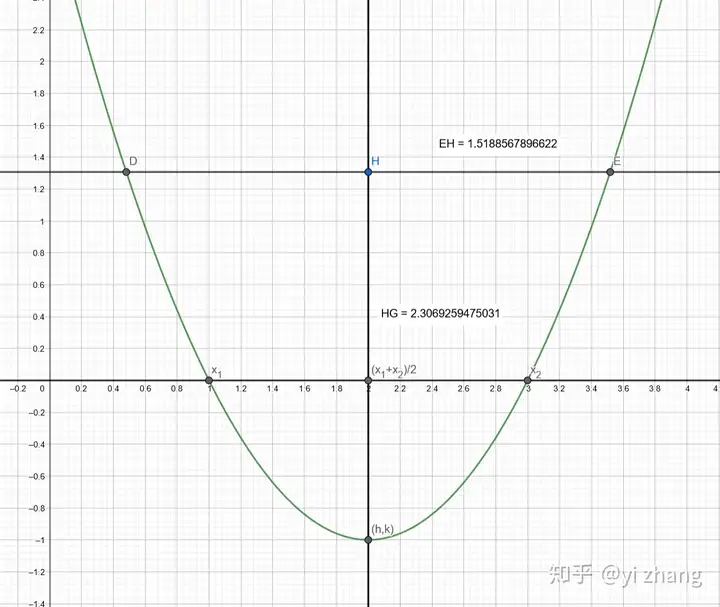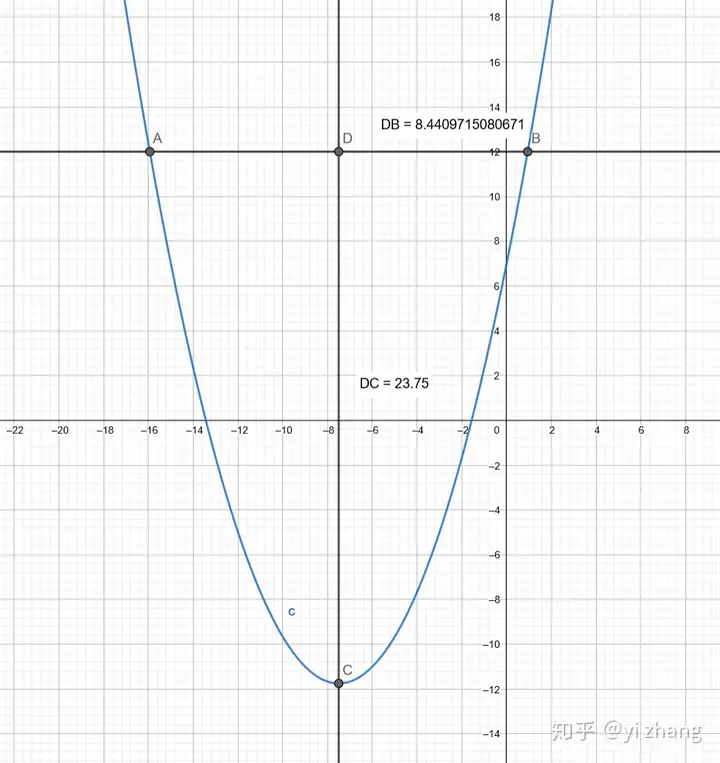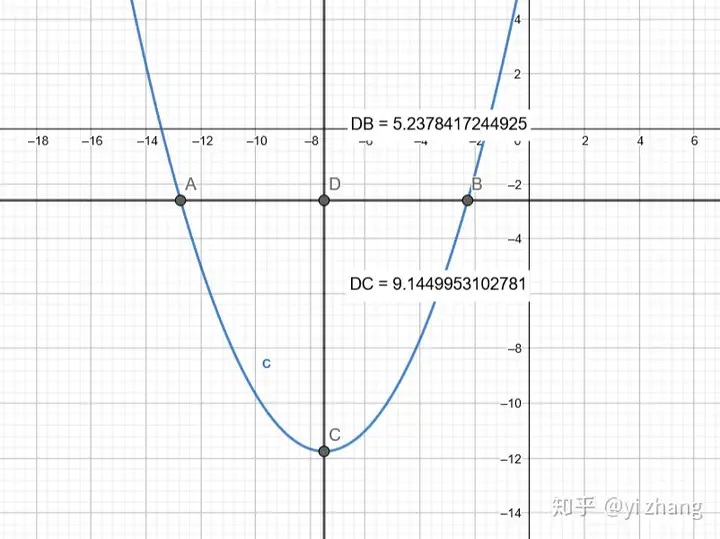|
');
(window.slotbydup=window.slotbydup || []).push({
id: '8096091',
container: s,
size: '580,90',
display: 'inlay-fix'
});
})();
以下是其基本概念和图像上特殊点。
常见三种形式。
(其中两根式当二次函数和x轴没有交点的时候不存在,此时可以采用更为一般的 对称点式y</mi><mo>=</mo><mi>a</mi><mrow class="MJX-TeXAtom-ORD"><mo>(</mo></mrow><mi>x</mi><mo>−</mo><msub><mi>x</mi><mn>1</mn></msub><mo stretchy="false">)</mo><mo stretchy="false">(</mo><mi>x</mi><mo>−</mo><msub><mi>x</mi><mn>2</mn></msub><mo stretchy="false">)</mo><mo>+</mo><mi>m</mi></math>" role="presentation" tabindex="0"> ,相当于函数 y</mi><mo>=</mo><mi>a</mi><mrow class="MJX-TeXAtom-ORD"><mo>(</mo></mrow><mi>x</mi><mo>−</mo><msub><mi>x</mi><mn>1</mn></msub><mo stretchy="false">)</mo><mo stretchy="false">(</mo><mi>x</mi><mo>−</mo><msub><mi>x</mi><mn>2</mn></msub><mo stretchy="false">)</mo></math>" role="presentation" tabindex="0"> 和直线y=m的两个交点,m为足够大的数)
其中出现过的字母有
a:二次项系数,在三个表达式中都出现过。代表开口大小。
b:一般式的一次项系数。
c:常数项系数
h:顶点式中顶点x坐标
k:顶点式中顶点y坐标
(此处会注意到为什么h前面是有负号,而k前面没有,如有疑惑,请看下面链接)
x_1: 两根式其中一个根
x_2:两根式其中另一个根
以下我以开口向上且和x轴有两个根的二次函数为例,介绍下三个表达式的联系以及适用范围。
如下图为例子:
(实际函数为一般式: y</mi><mo>=</mo><msup><mi>x</mi><mn>2</mn></msup><mo>−</mo><mn>4</mn><mi>x</mi><mo>+</mo><mn>3</mn></math>" role="presentation" tabindex="0"> 或者写成顶点式: y</mi><mo>=</mo><mo stretchy="false">(</mo><mi>x</mi><mo>−</mo><mn>2</mn><msup><mo stretchy="false">)</mo><mn>2</mn></msup><mo>−</mo><mn>1</mn></math>" role="presentation" tabindex="0"> 两根式: y</mi><mo>=</mo><mo stretchy="false">(</mo><mi>x</mi><mo>−</mo><mn>1</mn><mo stretchy="false">)</mo><mo stretchy="false">(</mo><mi>x</mi><mo>−</mo><mn>3</mn><mo stretchy="false">)</mo></math>" role="presentation" tabindex="0"> )
我们先认为 <mi>x</mi><mn>1</mn></msub><mo><</mo><msub><mi>x</mi><mn>2</mn></msub><mrow class="MJX-TeXAtom-ORD"><mo>,</mo></mrow></math>" role="presentation" tabindex="0">
那么可以得到几个点的坐标。
A</mi><mo>=</mo><mo stretchy="false">(</mo><msub><mi>x</mi><mn>1</mn></msub><mo>,</mo><mn>0</mn><mo stretchy="false">)</mo></math>" role="presentation" tabindex="0">
B</mi><mo>=</mo><mo stretchy="false">(</mo><msub><mi>x</mi><mn>2</mn></msub><mo>,</mo><mn>0</mn><mo stretchy="false">)</mo></math>" role="presentation" tabindex="0">
C</mi><mo>=</mo><mo stretchy="false">(</mo><mn>0</mn><mo>,</mo><mi>c</mi><mo stretchy="false">)</mo></math>" role="presentation" tabindex="0">
F</mi><mo>=</mo><mo stretchy="false">(</mo><mn>0</mn><mo>,</mo><mi>h</mi><mo stretchy="false">)</mo></math>" role="presentation" tabindex="0">
G</mi><mo>=</mo><mo stretchy="false">(</mo><mi>h</mi><mo>,</mo><mi>k</mi><mo stretchy="false">)</mo></math>" role="presentation" tabindex="0">
在此可以注意到,
2. b未出现,c是和y轴交点坐标属于一般式的。
3. h,k是属于顶点式的。(h,k)就是顶点坐标。
4. <mi>x</mi><mn>1</mn></msub><mo>,</mo><msub><mi>x</mi><mn>2</mn></msub></math>" role="presentation" tabindex="0"> 是属于两根式的。分别是和x轴的两个交点。
但既然同一个二次函数可以用三种方式来表达。那么很显然,三者之间必定存在关系,以及能够相互转化。
(其实上面说法不准确,对于和x轴没有交点的无法采用两根式)
将一般式化成顶点式(这是任何情况下都成立的)
y</mi><mo>=</mo><mi>a</mi><msup><mi>x</mi><mn>2</mn></msup><mo>+</mo><mi>b</mi><mi>x</mi><mo>+</mo><mi>c</mi></math>" role="presentation" tabindex="0">
y</mi><mo>=</mo><mi>a</mi><mo stretchy="false">(</mo><msup><mi>x</mi><mn>2</mn></msup><mo>+</mo><mfrac><mi>b</mi><mi>a</mi></mfrac><mi>x</mi><mo stretchy="false">)</mo><mo>+</mo><mi>c</mi></math>" role="presentation" tabindex="0">
y</mi><mo>=</mo><mi>a</mi><mo stretchy="false">(</mo><msup><mi>x</mi><mn>2</mn></msup><mo>+</mo><mfrac><mi>b</mi><mi>a</mi></mfrac><mi>x</mi><mo>+</mo><mo stretchy="false">(</mo><mfrac><mi>b</mi><mrow><mn>2</mn><mi>a</mi></mrow></mfrac><msup><mo stretchy="false">)</mo><mn>2</mn></msup><mo>−</mo><mo stretchy="false">(</mo><mfrac><mi>b</mi><mrow><mn>2</mn><mi>a</mi></mrow></mfrac><msup><mo stretchy="false">)</mo><mn>2</mn></msup><mo stretchy="false">)</mo><mo>+</mo><mi>c</mi></math>" role="presentation" tabindex="0">
y</mi><mo>=</mo><mi>a</mi><mo stretchy="false">(</mo><msup><mi>x</mi><mn>2</mn></msup><mo>+</mo><mfrac><mi>b</mi><mi>a</mi></mfrac><mi>x</mi><mo>+</mo><mo stretchy="false">(</mo><mfrac><mi>b</mi><mrow><mn>2</mn><mi>a</mi></mrow></mfrac><msup><mo stretchy="false">)</mo><mn>2</mn></msup><mo stretchy="false">)</mo><mo>−</mo><mi>a</mi><mo stretchy="false">(</mo><mfrac><mi>b</mi><mrow><mn>2</mn><mi>a</mi></mrow></mfrac><msup><mo stretchy="false">)</mo><mn>2</mn></msup><mo>+</mo><mi>c</mi></math>" role="presentation" tabindex="0">
y</mi><mo>=</mo><mi>a</mi><mo stretchy="false">(</mo><mi>x</mi><mo>+</mo><mfrac><mi>b</mi><mrow><mn>2</mn><mi>a</mi></mrow></mfrac><msup><mo stretchy="false">)</mo><mn>2</mn></msup><mo>−</mo><mi>a</mi><mo stretchy="false">(</mo><mfrac><mi>b</mi><mrow><mn>2</mn><mi>a</mi></mrow></mfrac><msup><mo stretchy="false">)</mo><mn>2</mn></msup><mo>+</mo><mi>c</mi></math>" role="presentation" tabindex="0">
y</mi><mo>=</mo><mi>a</mi><mo stretchy="false">(</mo><mi>x</mi><mo>+</mo><mfrac><mi>b</mi><mrow><mn>2</mn><mi>a</mi></mrow></mfrac><msup><mo stretchy="false">)</mo><mn>2</mn></msup><mo>+</mo><mfrac><mrow><mn>4</mn><mi>a</mi><mi>c</mi><mo>−</mo><msup><mi>b</mi><mn>2</mn></msup></mrow><mrow><mn>4</mn><mi>a</mi></mrow></mfrac></math>" role="presentation" tabindex="0">
通过对比 y</mi><mo>=</mo><mi>a</mi><mrow class="MJX-TeXAtom-ORD"><mo>(</mo></mrow><mi>x</mi><mo>−</mo><mi>h</mi><msup><mrow class="MJX-TeXAtom-ORD"><mo>)</mo></mrow><mn>2</mn></msup><mo>+</mo><mi>k</mi></math>" role="presentation" tabindex="0"> 可以发现
h</mi><mo>=</mo><mo>−</mo><mfrac><mi>b</mi><mrow><mn>2</mn><mi>a</mi></mrow></mfrac></math>" role="presentation" tabindex="0">
k</mi><mo>=</mo><mfrac><mrow><mn>4</mn><mi>a</mi><mi>c</mi><mo>−</mo><msup><mi>b</mi><mn>2</mn></msup></mrow><mrow><mn>4</mn><mi>a</mi></mrow></mfrac></math>" role="presentation" tabindex="0">
2. 一般式和两根式
由, y</mi><mo>=</mo><mi>a</mi><mo stretchy="false">(</mo><mi>x</mi><mo>+</mo><mfrac><mi>b</mi><mrow><mn>2</mn><mi>a</mi></mrow></mfrac><msup><mo stretchy="false">)</mo><mn>2</mn></msup><mo>+</mo><mfrac><mrow><mn>4</mn><mi>a</mi><mi>c</mi><mo>−</mo><msup><mi>b</mi><mn>2</mn></msup></mrow><mrow><mn>4</mn><mi>a</mi></mrow></mfrac></math>" role="presentation" tabindex="0">
令y=0
就能得到一元二次方程的求根公式
0</mn><mo>=</mo><mi>a</mi><mo stretchy="false">(</mo><mi>x</mi><mo>+</mo><mfrac><mi>b</mi><mrow><mn>2</mn><mi>a</mi></mrow></mfrac><msup><mo stretchy="false">)</mo><mn>2</mn></msup><mo>+</mo><mfrac><mrow><mn>4</mn><mi>a</mi><mi>c</mi><mo>−</mo><msup><mi>b</mi><mn>2</mn></msup></mrow><mrow><mn>4</mn><mi>a</mi></mrow></mfrac></math>" role="presentation" tabindex="0">
0</mn><mo>=</mo><mo stretchy="false">(</mo><mi>x</mi><mo>+</mo><mfrac><mi>b</mi><mrow><mn>2</mn><mi>a</mi></mrow></mfrac><msup><mo stretchy="false">)</mo><mn>2</mn></msup><mo>+</mo><mfrac><mrow><mn>4</mn><mi>a</mi><mi>c</mi><mo>−</mo><msup><mi>b</mi><mn>2</mn></msup></mrow><mrow><mn>4</mn><msup><mi>a</mi><mn>2</mn></msup></mrow></mfrac></math>" role="presentation" tabindex="0">
(</mo><mi>x</mi><mo>+</mo><mfrac><mi>b</mi><mrow><mn>2</mn><mi>a</mi></mrow></mfrac><msup><mo stretchy="false">)</mo><mn>2</mn></msup><mo>=</mo><mfrac><mrow><msup><mi>b</mi><mn>2</mn></msup><mo>−</mo><mn>4</mn><mi>a</mi><mi>c</mi></mrow><mrow><mn>4</mn><msup><mi>a</mi><mn>2</mn></msup></mrow></mfrac></math>" role="presentation" tabindex="0">
x</mi><mo>+</mo><mfrac><mi>b</mi><mrow><mn>2</mn><mi>a</mi></mrow></mfrac><mo>=</mo><mo>±</mo><mfrac><msqrt><msup><mi>b</mi><mn>2</mn></msup><mo>−</mo><mn>4</mn><mi>a</mi><mi>c</mi></msqrt><mrow><mn>2</mn><mi>a</mi></mrow></mfrac></math>" role="presentation" tabindex="0">
<mi>x</mi><mn>1</mn></msub><mo>,</mo><msub><mi>x</mi><mn>2</mn></msub><mo>=</mo><mfrac><mrow><mo>−</mo><mi>b</mi><mo>±</mo><msqrt><msup><mi>b</mi><mn>2</mn></msup><mo>−</mo><mn>4</mn><mi>a</mi><mi>c</mi></msqrt></mrow><mrow><mn>2</mn><mi>a</mi></mrow></mfrac></math>" role="presentation" tabindex="0">
按照前面的预设 <mi>x</mi><mn>1</mn></msub><mo><</mo><msub><mi>x</mi><mn>2</mn></msub></math>" role="presentation" tabindex="0">
那么 <mi>x</mi><mn>1</mn></msub><mo>=</mo><mfrac><mrow><mo>−</mo><mi>b</mi><mo>−</mo><msqrt><msup><mi>b</mi><mn>2</mn></msup><mo>−</mo><mn>4</mn><mi>a</mi><mi>c</mi></msqrt></mrow><mrow><mn>2</mn><mi>a</mi></mrow></mfrac></math>" role="presentation" tabindex="0">
<mi>x</mi><mn>2</mn></msub><mo>=</mo><mfrac><mrow><mo>−</mo><mi>b</mi><mo>+</mo><msqrt><msup><mi>b</mi><mn>2</mn></msup><mo>−</mo><mn>4</mn><mi>a</mi><mi>c</mi></msqrt></mrow><mrow><mn>2</mn><mi>a</mi></mrow></mfrac></math>" role="presentation" tabindex="0">
通过简单的加减就能得到
<mi>x</mi><mn>1</mn></msub><mo>+</mo><msub><mi>x</mi><mn>2</mn></msub><mo>=</mo><mo>−</mo><mfrac><mi>b</mi><mi>a</mi></mfrac></math>" role="presentation" tabindex="0">
<mi>x</mi><mn>2</mn></msub><mo>−</mo><msub><mi>x</mi><mn>1</mn></msub><mo>=</mo><mfrac><msqrt><msup><mi>b</mi><mn>2</mn></msup><mo>−</mo><mn>4</mn><mi>a</mi><mi>c</mi></msqrt><mi>a</mi></mfrac></math>" role="presentation" tabindex="0">
<mi>x</mi><mn>1</mn></msub><msub><mi>x</mi><mn>2</mn></msub><mo>=</mo><mfrac><mi>c</mi><mi>a</mi></mfrac></math>" role="presentation" tabindex="0">
(其中1,3式就是韦达定理)
或者将 y</mi><mo>=</mo><mi>a</mi><mrow class="MJX-TeXAtom-ORD"><mo>(</mo></mrow><mi>x</mi><mo>−</mo><msub><mi>x</mi><mn>1</mn></msub><mo stretchy="false">)</mo><mo stretchy="false">(</mo><mi>x</mi><mo>−</mo><msub><mi>x</mi><mn>2</mn></msub><mo stretchy="false">)</mo></math>" role="presentation" tabindex="0"> 开括号
y</mi><mo>=</mo><mi>a</mi><msup><mi>x</mi><mn>2</mn></msup><mo>−</mo><mi>a</mi><mrow class="MJX-TeXAtom-ORD"><mo>(</mo></mrow><msub><mi>x</mi><mn>1</mn></msub><mo>+</mo><msub><mi>x</mi><mn>2</mn></msub><mo stretchy="false">)</mo><mi>x</mi><mo>+</mo><mi>a</mi><msub><mi>x</mi><mn>1</mn></msub><msub><mi>x</mi><mn>2</mn></msub></math>" role="presentation" tabindex="0">
也能对比出
b</mi><mo>=</mo><mo>−</mo><mi>a</mi><mo stretchy="false">(</mo><msub><mi>x</mi><mn>1</mn></msub><mo>+</mo><msub><mi>x</mi><mn>2</mn></msub><mo stretchy="false">)</mo></math>" role="presentation" tabindex="0">
c</mi><mo>=</mo><mi>a</mi><msub><mi>x</mi><mn>1</mn></msub><msub><mi>x</mi><mn>2</mn></msub></math>" role="presentation" tabindex="0">
3. 顶点式和两根式
从上面的b</mi><mo>=</mo><mo>−</mo><mi>a</mi><mo stretchy="false">(</mo><msub><mi>x</mi><mn>1</mn></msub><mo>+</mo><msub><mi>x</mi><mn>2</mn></msub><mo stretchy="false">)</mo></math>" role="presentation" tabindex="0">以及 h</mi><mo>=</mo><mo>−</mo><mfrac><mi>b</mi><mrow><mn>2</mn><mi>a</mi></mrow></mfrac></math>" role="presentation" tabindex="0">
可以看出, h</mi><mo>=</mo><mfrac><mrow><msub><mi>x</mi><mn>1</mn></msub><mo>+</mo><msub><mi>x</mi><mn>2</mn></msub></mrow><mn>2</mn></mfrac></math>" role="presentation" tabindex="0">
当然也可以直观的从函数图形上得到。
二次函数的对称轴就是 <mi>x</mi><mn>1</mn></msub><mo>,</mo><msub><mi>x</mi><mn>2</mn></msub></math>" role="presentation" tabindex="0"> 连线的中点。
接下来对于顶点的纵坐标就并不那么直观了。
从代数上,我们观察下面两个式子。
<mi>x</mi><mn>2</mn></msub><mo>−</mo><msub><mi>x</mi><mn>1</mn></msub><mo>=</mo><mfrac><msqrt><msup><mi>b</mi><mn>2</mn></msup><mo>−</mo><mn>4</mn><mi>a</mi><mi>c</mi></msqrt><mi>a</mi></mfrac></math>" role="presentation" tabindex="0">
k</mi><mo>=</mo><mfrac><mrow><mn>4</mn><mi>a</mi><mi>c</mi><mo>−</mo><msup><mi>b</mi><mn>2</mn></msup></mrow><mrow><mn>4</mn><mi>a</mi></mrow></mfrac></math>" role="presentation" tabindex="0">
能够发现 k</mi><mo>=</mo><mo>−</mo><mfrac><mrow><mi>a</mi><mo stretchy="false">(</mo><msub><mi>x</mi><mn>2</mn></msub><mo>−</mo><msub><mi>x</mi><mn>1</mn></msub><msup><mo stretchy="false">)</mo><mn>2</mn></msup></mrow><mn>4</mn></mfrac></math>" role="presentation" tabindex="0">
也就是k等于a/4*两根之间距离的平方的相反数。
我们也可以从几何上直观的看出来
还是以y</mi><mo>=</mo><msup><mi>x</mi><mn>2</mn></msup><mo>−</mo><mn>4</mn><mi>x</mi><mo>+</mo><mn>3</mn></math>" role="presentation" tabindex="0">为例,
显然任意一个根到对称轴的距离为 <mrow><msub><mi>x</mi><mn>2</mn></msub><mo>−</mo><msub><mi>x</mi><mn>1</mn></msub></mrow><mn>2</mn></mfrac></math>" role="presentation" tabindex="0"> ,因为抛物线任意平移形状不变。也就是我可以将任意抛物线平移后得到形如 y</mi><mo>=</mo><mi>a</mi><msup><mi>x</mi><mn>2</mn></msup></math>" role="presentation" tabindex="0"> ,例如 y</mi><mo>=</mo><mfrac><mn>1</mn><mn>2</mn></mfrac><msup><mi>x</mi><mn>2</mn></msup></math>" role="presentation" tabindex="0"> ,
横纵坐标保持着,纵坐标=1/2*横坐标的平方关系
而其实这种平方关系存在于任意的抛物线,只要是对称轴上点就有的性质,即使和x轴没有交点,取一个尽可能大的数值,总能和抛物线相交两点。
我在对称轴上取一点H (对于这开口向上的抛物线,H点要在顶点上方)过H做直线平行x轴,交抛物线于D,E两点。
任意移动H点,可以发现 H</mi><mi>G</mi><mo>≡</mo><mi>E</mi><msup><mi>H</mi><mn>2</mn></msup></math>" role="presentation" tabindex="0">
在来一个 a</mi><mo>≠</mo><mn>1</mn></math>" role="presentation" tabindex="0"> 的二次函数试下。
比如 y</mi><mo>=</mo><mfrac><mn>1</mn><mn>3</mn></mfrac><msup><mi>x</mi><mn>2</mn></msup><mo>+</mo><mn>5</mn><mi>x</mi><mo>+</mo><mn>7</mn></math>" role="presentation" tabindex="0">
当BD=8.44时候,DC=23.75=8.44*8.44/3
当BD=5.24时候,DC=9.14=5.24*5.24/3
上述总结,对于任意抛物线来说,抛物线上点的到对称轴的距离的平分*a=这个点和顶点之间的纵坐标之差。 |


